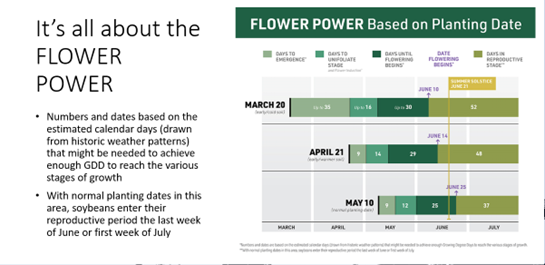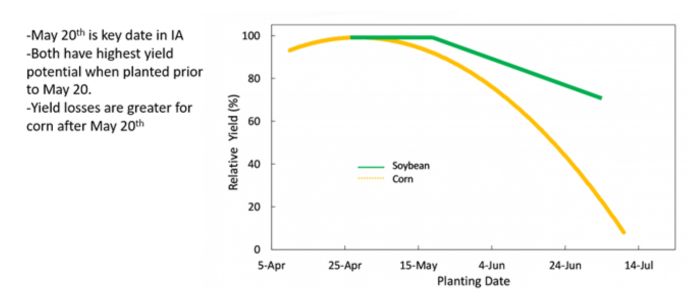Determining Your Soybean Planting Date: Early vs Late
Eric Solberg, Eastern Product Agronomist
April 15, 2024
Benefits and risks of early planting
- Trends toward larger farms and planting equipment size along with the availability of effective seed treatments and proven yield benefits have prompted a shift toward earlier planting of soybeans.
- Several Corteva Agriscience agronomy research studies have shown the
benefits of early planting with a full-season soybean variety for maximizing soybean yield. - Early planted soybeans generally reach canopy closure
sooner, intercept more sunlight, and spend a longer duration
in reproductive growth. - However, it is possible to plant too early every year, and
several management factors and risks associated with early
planting must be considered. - Cold and wet conditions at and after planting can injure
developing seedlings, delay germination and emergence, and
reduce stand establishment.
Soil temperature
- Like corn, soybeans are typically planted into soils well
below their optimum temperature for germination, making
early growth conditions are inherently stressful. The optimum
temperature for soybean germination is around 70º F (21º C). - Soybeans typically require between 90 and 130 GDUs to
emerge, depending upon soil type. - A minimum soil temperature of 50º F (10º C) during
the 24 hours following planting is recommended. At
soil temperatures below 50º F (10º C), the risk of slow
germination, infection of seedling diseases, and reduced
stand establishment increases. - The GDU requirement of soybean is similar to corn with a base temperature of 50º F (10º C). Thus, planting ahead of a cold spell often does not result in the accumulation of additional GDUs or gain any early growth.
Imbibitional chilling and risk of freezing
- The initial uptake of water into the seed following planting is referred to as the imbibitional phase. A soybean seed imbibes approximately 50% of its weight in water during germination
- The imbibitional phase occurs very rapidly after planting, typically not lasting more than 24 hours.
- Imbibitional chilling injury and stand loss can occur when very cold soil water (< 40º F, 4º C) is imbibed by the seed during this time. A damaged seed coat can increase the likelihood of imbibitional chilling injury. Care should be taken when handling/treating seed.
- Aim for planting in late morning or early afternoon when soil temps. May be greater than 50 degrees.
- Once the imbibitional phase is completed, the risk of chilling injury associated with cold soil temperature or rain declines.
- Emerged soybeans are more susceptible to damage from freezing temperatures than corn because their growing points are above the soil surface as soon as the plants emerge.
- Increase seeding rates by 10-20% to account for emergence losses and seedling disease mortality. The ultimate goal is to have100,000 plants/ac at harvest time.

Yield potential response to planting date for corn and soybeans in Iowa

Risk vs. Reward
- The goal of early soybean planting is to get plants to flower before the summer solstice on June 21. At the unifoliate stage (two leaves on opposite sides of the stem, across from each other), the plant begins to sense night length. If the nights are long enough (that is, sufficient hours of darkness), the plant’s internal clock tells it to start flowering, the beginning of the reproductive, or grain-fill, stage. Flowering shifts back into normal or low gear after the solstice.
- “It all comes down to the natural environment,” says Ken Ferrie, Farm Journal Field Agronomist. “A warm April makes this much easier to accomplish. With a cold April and first half of May, we might not get enough Growing Degree Days to reach the unifoliate stage before the critical photoperiod passes.”
Other Considerations
- If conditions are right to plant corn, then plant corn, rather than soybeans, if you are unable to plant both crops at the same time. Soybeans, unlike corn, can tolerate marginal planting conditions. In fact, days when you know you are pushing the envelope for corn planting are good days to plant soybeans.
- Plant only as many acres as you are comfortable with because a freeze in May could kill all your early-planted soybeans.
- Early-planted soybeans will reach the reproductive stages earlier than normal. Base post-emergence herbicide application on the stage of soybean growth, not on plant height or calendar days from planting. Failing to do so could cause plants to abort flowers.
- Planting soybeans ahead of corn requires planning. If you use tillage, fields must be level enough to plant as you come into spring. Trying to prepare fields for corn and soybeans at the same time might cause you to miss corn’s optimum planting window.
Agronomist Contact Info
Eric Solberg
Eastern Region Product Agronomist
e.solberg@hoegemeyer.com
Sources
